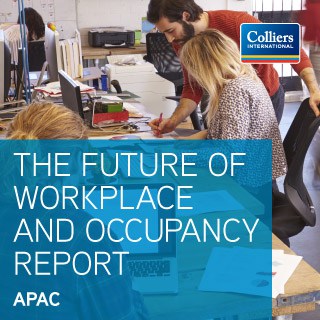
Truddy Cheung, Associate Director and Head of Workplace Solutions for North Asia at Colliers International
According to a new report from Colliers International (NASDAQ and TSX: CIGI), a global leader in commercial real estate services, landlords and occupiers will reap the benefits of opportunities presented by preparing for the workplace of the future. The Future of Workplace and Occupancy Report, Asia 2017 identifies five major shifts that businesses need to make in the workplace over the next five years.
Duncan White, Head of Office Services at Colliers International, Singapore, commented, “This report looks at what the future holds for both landlords and occupiers, and recommends actionable ideas to help prepare them for the future. As the workplace remains under pressure to evolve, we discern current trends, and engage in forward-looking discussions to identify key drivers for the workplace of the future. From employee wellness, engagement, attraction and retention, to Internet of Things, thought leadership and excellence as well as development and collaboration, we present our insight into the future of workplace and occupancy.”
Five Major Shifts
 According to Colliers’ newly released report, the five major shifts that will contribute to the development of the workplace of the future are:
According to Colliers’ newly released report, the five major shifts that will contribute to the development of the workplace of the future are:
• Make employee experience a core part of business strategy
Commenting on this strategy, Duncan said: “A concept such as the Concierge Model, brings a service-oriented hospitality mind set into the workplace and helps employees with mundane tasks, which in turn allows them to focus on their work in a more effective manner, making them happier and more productive.”
• Build the “Internet of Workplace”
The report suggests a strategy shift for digital integration in the workplace, in which nice-to-have amenities will become core functionalities that make the workplace reactive and proactive to get ahead of the automation impact.
• Create a workplace that makes people healthier
This strategy implies that productivity will increase with less sick days, higher energy and greater consistency amongst employees. The report envisions that in five to 15 years’ time, there should be no boundary between the office lifestyle, as well as the office and health in general.
• Ingrain coworking mentality in real estate strategy
Commenting on this strategy, Duncan said: “The biggest shift in the coming years is that coworking will become a key component of many companies’ real estate strategies — occupiers and building owners alike. Companies need to identify core versus flexible work spaces, where better decisions can be made on how to execute a real estate strategy that minimises cost and maximises flexibility.”
• Enable an agile organisation
By aligning work environment with agile workplace concepts, companies will be better placed to adapt, and stay one step ahead of change. The future of the workplace will hold the agility of employees within an organisation as a key performer for the increasing productivity and profitability desired by all for expansive success.
As the workplace of the future evolves over the next decade, the report anticipates key drivers to be technology, people, culture, and flexibility. Regional and global offices will begin acting as one office, taking advantage of the communities that organisations build. Samarth Kasturia, Associate Director & Head of Workplace Solutions for Southeast Asia at Colliers International, commented: “True agility is fast becoming a core contributor to designing effective organisations – helping retain and attract great talent, hedging against economic fluctuations, and increasing the adaptability quotient of organisations in an ever evolving business environment.
Creating workplace portfolios that reflect this business strategy to drive productivity and collaboration is going to be the key focus for most corporate occupiers in the near future. ‘The Future of Workplace and Occupancy’ provides actionable insights for occupiers to understand concepts such as coworking and its impact on organisational agility.”
Developers and landlords will build for flexible and transient working environments focusing on securing long-term tenants who can “breathe” within the space they occupy, enabling them to remain occupiers within the development even when they outgrow their space. Office developments will become more flexible, efficient, as well as sustainable, and will engage the wellness of people as a standard and mandated consideration to attract the best calibre of tenants.
Truddy Cheung, Associate Director & Head of Workplace Solutions for North Asia at Colliers International, added: “Work is changing. Workplaces are looking very different. Nowadays we have activity-based workplaces, co-working spaces, and agile workplaces. These are just some of the concepts of what an effective and collaborative workplace would look like. How do we identify what kind of transformation our workplace should take? What should be the areas of focus to make this decision? It is now up to the occupiers to decide which approach to adopt or adapt. There are valuable insights from the ‘The Future of Workplace and Occupancy’ to kick off a brainstorming session within any organisation.”
This sponsored feature was contributed by Colliers International, Asia Pacific. To download a copy ofThe Future of Workplace and Occupancy Report, Asia 2017, click here.
Leave a Reply